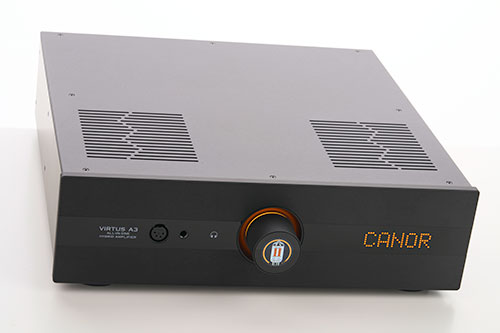If you want to achieve a linear phase response in the frequency range from 20 hertz to 20 kilohertz, you need a linear frequency response of five octaves above 20 kilohertz, i.e. up to 640 kilohertz. The MM-PH-AMP therefore operates linearly up to 800 kilo- or 1 megahertz, depending on the set amplification factor. Since the same naturally applies to frequencies below 20 hertz, Matej Kelc does without a subsonic filter and lets the phono equalizer work linearly down to a cut-off frequency of 3.2 hertz. Incidentally, the darTZeel developer Hervé Delétraz argues in a very similar way in the first part of the interview that I conducted with him back in July of this year.
Matej Kelc achieves the desired linear phase response with the MM-PH-AMP by using op-amps before and after the passive equalization, which only have to provide an amplification of 30 decibels, therefore being able to operate over a very wide bandwidth. MK Analogue’s phono stage offers a selectable gain of 40, 43 or 46 decibels. In addition to the usual 47 kiloohms, it also offers the terminating impedances 33, 68 and 100 kiloohms and four different termination capacities between 50 and 470 picofarads. For operation with the SUT-1L, 150 or 250 picofarads and the highest possible gain setting are recommended.
In my experience, all Ortofon SPUs sound better when their signals run through the silver windings of an Ortofon SPU-T100 connected to the MM input of a phono preamp instead of being processed in a phono pre-pre with an MC input. So I installed my SPU Century to the Ortofon AS-309R and used it to burn-in the MK Analogue combo. On the advice of Markus Wierl, I had equipped the two RCA jacks on the SUT-1L with the yellow-ringed RCA plugs to set the optimal termination impedance for the Century. Between the tonearm and the transformer and between the transformer and the MM-PH-AMP, I used cables from MK Analogue, which are really affordable at prices below 250 euros for a length of 90 centimeters. But before doing so, I had rummaged around in a compartment of the record rack where LPs I had bought years ago and not yet listened to were gathering dust. Among other titles, I found Wild Percussion And Horns A'Plenty (Living Stereo LSP-2289) by Dick Schory's New Percussion Ensemble, cleaned it in the record washer and put it on shortly afterwards.

The album was recorded in Chicago's Orchestra Hall, as was Bang, Barroom And Harp before it, and is characterized by an impressive spatial imaging – at least when the SPU-T100 is used on the MK Analogue MM-PH-AMP. The abundance of instruments and the witty arrangement of ‘Stumbling’ are simply a lot of fun. The brass sections and the timpani coming from the depths of the room pack a punch: It is simply impossible to remain unmoved and uninvolved in the listening chair. As expected, this is no different with the SUT-1L. The track appeals to you emotionally just as intense as before. What I hadn't reckoned with, though, is that now, in addition to the equally gripping groove, some hi-fi aspects are coming into focus again: With the best will in the world, you can't help but notice that the recording space suddenly seems to have grown in all dimensions and the multitude of actors is a little further away from each other and surrounded by more air. I also like the following tracks better when listened through the SUT-1L than through the SPU-T100. Well, it could be an advantage that the two MK Analogue devices and the inexpensive cables from the same company simply harmonize better with each other. Nevertheless, I had also created a suitable environment for Ortofon’s silver transformer: I connected it to the tonearm via the Ortofon TSW-5000-Silver and to the MM phono stage via the AC-5000-Silver. However, it does sound better through the SUT-1L!
But wait, let’s give the SPU-T100 another chance: Having Pictures at an Exhibition as interpreted by the Chicago Symphony Orchestra conducted by Carlo Maria Giulini lying on the platter of the LaGrange, ‘The Hut of Baba Yaga’ and ‘The Great Gates of Kiev’ sound as dynamic and airy as ever through the silver transformer. After switching to the SUT-1L, the recording space appears to be a little larger and the musicians a bit more engaged. Despite a touch more of dynamics and openness, there is not even a hint of roughness or sharpness in the MK Analogue’s rendition, unlike the Ortofon. The SUT-1L pampers with a smoother musical flow and a more coherent tonality. Very impressive, indeed!

























 |
|


















































































